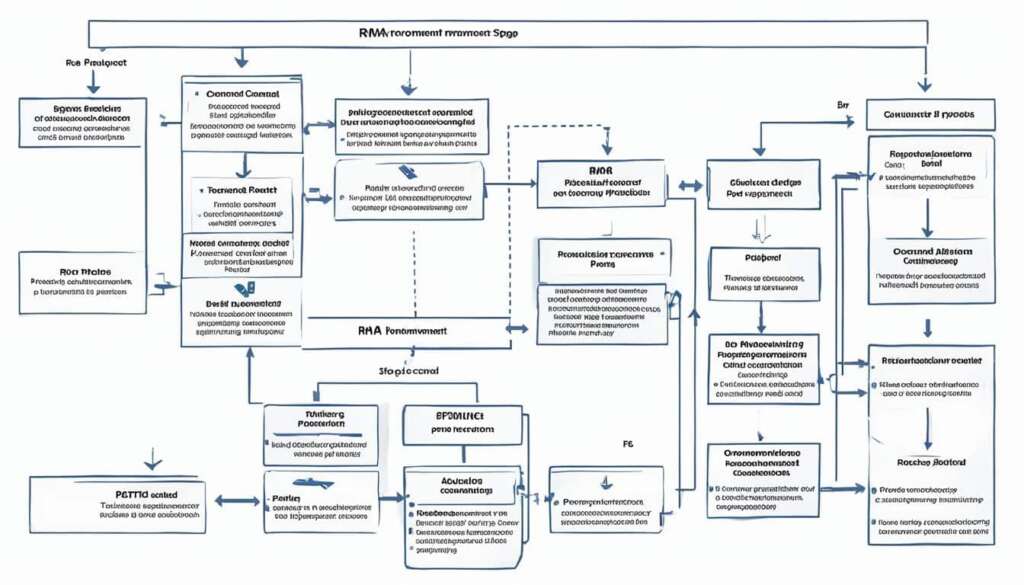Table of Contents
In this comprehensive guide, we will explore the concept of Return Merchandise Authorization (RMA) and its importance in the return process. RMA, also known as return authorization or return goods authorization, is the initial step in managing product returns. It allows customers to request returns, exchanges, or repairs and provides valuable data for merchants to improve the customer journey. The RMA process varies across different industries and merchants, but it typically involves a series of steps, including customer requests, evaluation, shipping, product inspection, and resolution. Implementing a customer-centric RMA system is crucial for enhancing customer satisfaction, reducing return rates, and improving the overall customer experience.
In this guide, we will delve into the purpose of RMA in ecommerce, the different options available in the RMA process, the benefits of a customer-centric RMA policy, the key elements of an RMA system, the steps and best practices for a smooth RMA process, the role of an RMA account, and the parties involved in RMA processes. By understanding these aspects, businesses can effectively manage product returns, enhance customer satisfaction, and optimize their operations.
The Purpose of RMA in Ecommerce
RMA (Return Merchandise Authorization) plays a critical role in ecommerce by providing a structured process for managing product returns. It serves as the initiation point for return requests and helps determine the appropriate course of action, such as refunds, store credits, exchanges, or repairs.
RMA facilitates the return process for customers, ensuring a smooth and frictionless experience. By offering clear return policies and guidelines, ecommerce businesses can build trust and enhance the customer journey.
Moreover, RMA provides valuable data for merchants. By analyzing return data, merchants can gain insights into the reasons behind returns, identify patterns or product issues, and make informed decisions to improve their offerings and customer experience.
An effective RMA system is crucial for managing return data efficiently. Returns management solutions, such as ReturnLogic, automate and streamline the returns process, making it more efficient and customer-friendly.
By leveraging a returns management solution, merchants can:
- Improve operational efficiency
- Reduce processing time for returns
- Enhance data accuracy
- Track return status and progress
With a robust RMA process and returns management solution in place, ecommerce businesses can optimize their operations, minimize losses, and create a seamless return experience for customers.
Different Options in the RMA Process
The RMA process provides customers and merchants with a range of options to ensure a satisfactory resolution. When initiating a return, customers can choose from the following options:
1. Refund
An option for customers is to receive a refund, where the original payment is repaid. This allows customers to recoup their money for the returned product.
2. Store Credit
Another choice is to receive store credit. This enables customers to receive a credit amount that they can use for future purchases, providing them with flexibility and the opportunity to find a suitable replacement or alternative item.
3. Exchange
Customers may opt for an exchange if they wish to receive a different size, color, or item. This option allows them to swap the returned product with a suitable alternative that meets their needs.
4. Warranty
For certain products, warranties may be available. This option allows customers to replace or repair any defective items, ensuring their satisfaction and product functionality.
5. Third-Party Warranty
Ecommerce merchants with an omnichannel presence can offer customers the option to utilize third-party warranties. These warranties cover items purchased from retailers and can provide an additional level of support and peace of mind for customers.
6. No-Shipping Option
In some verticals, a no-shipping option may be available. This option is particularly relevant for non-restockable items, eliminating the need for customers to go through the hassle of shipping the product back.
7. Reject
Merchants may reject a return if it falls outside of the return window or if the item is damaged beyond reasonable repair. However, it is essential for merchants to clearly define and communicate their return policy to avoid any customer disappointment.
By offering these various options, the RMA process aims to provide customers with flexibility and ensure their satisfaction, while also supporting merchants in managing returns effectively.
For a visual representation of the different options in the RMA process, refer to the table below:
| Return Option | Description |
|---|---|
| Refund | Original payment is repaid to the customer. |
| Store Credit | Customer receives credit for future purchases. |
| Exchange | Customer can swap the returned product for a different size, color, or item. |
| Warranty | Customers can replace or repair defective items covered by a warranty. |
| Third-Party Warranty | Ecommerce merchants offer third-party warranties for items purchased from retailers. |
| No-Shipping Option | Option for certain verticals where customers don’t need to ship the product back. |
| Reject | Merchants may reject returns falling outside the return window or damaged beyond repair. |
By understanding the different options available, both customers and merchants can navigate the RMA process with clarity and confidence.
Benefits of a Customer-Centric RMA Policy
A customer-centric RMA policy is crucial in enhancing customer satisfaction and loyalty. By providing a smooth and flexible returns process, merchants can win back dissatisfied customers and transform them into enthusiastic brand advocates. This not only improves customer sentiment but also helps in reducing negative reviews, which can have a significant impact on potential buyers.
RMA also serves as an excellent data collection point for merchants. Each return request offers valuable insights into customer behavior and product issues. By analyzing this data, merchants can identify patterns and make data-driven decisions to improve product quality, onsite optimization, and acquisition strategies.
“A customer-centric RMA policy is crucial in enhancing customer satisfaction and loyalty.”
Furthermore, an efficient RMA process aids in reducing return rates. By streamlining the returns process with clear instructions and proactive customer support, merchants can minimize the number of returns and improve overall customer experience. This, in turn, helps in maintaining higher customer lifetime value and drives repeat business.
Key Benefits of a Customer-Centric RMA Policy:
- Enhanced customer satisfaction and loyalty
- Valuable data collection for insights into customer behavior and product issues
- Improvement in product quality, onsite optimization, and acquisition strategies
- Reduction in return rates
- Improved customer experience and increased customer lifetime value
In conclusion, a customer-centric RMA policy is not just essential for handling returns efficiently; it also contributes to the overall success of a business. By prioritizing customer satisfaction, collecting valuable data, and continuously improving products and processes, merchants can create a positive customer experience and build long-lasting relationships with their customers.

Key Elements of an RMA System
An effective RMA system consists of several key elements that work in tandem to ensure a smooth and efficient return process. These elements include:
RMA Forms
RMA forms are essential documents that customers complete when requesting a return. These forms collect important information such as product details and reasons for return. By providing detailed information, customers enable businesses to understand the nature of the return and assess the appropriate course of action.
RMA Numbers
Each return request is assigned a unique RMA number. This number serves as a reference for tracking the status of the return throughout the process. It helps businesses effectively manage and monitor a large volume of returns, ensuring that each case receives proper attention and resolution.
RMA Workflow
The RMA workflow guides both customers and businesses through the various steps of the return process. From initiating the request to resolving the return, the workflow ensures that each stage is followed systematically and accurately. By providing a clear path, the RMA workflow streamlines operations, minimizes errors, and enhances overall efficiency.
Return Policy
A clear and concise return policy is essential to set expectations and facilitate a smooth returns experience. It outlines the conditions, timeframe, and procedures for returning products. By clearly communicating the return policy, businesses avoid confusion and manage customer expectations effectively, leading to increased customer satisfaction.
Product Inspection
Product inspection is a crucial step in the RMA process. It involves assessing the condition of returned items to determine the appropriate resolution, whether it be repair, replacement, or refund. Thorough product inspection ensures that businesses make informed decisions, minimizing any potential loss and ensuring customer satisfaction.
By incorporating these key elements into their RMA system, businesses can efficiently manage returns, improve customer satisfaction, and streamline their operations.
“An effective RMA system is the backbone of a seamless return process, providing structure and clarity for both customers and businesses.”
The RMA Process: Steps and Best Practices
The Return Merchandise Authorization (RMA) process is essential for a structured and efficient return experience. It encompasses several key steps and best practices that help streamline the process and ensure customer satisfaction.
Step 1: Customer Request
The RMA process begins with a customer initiating a return request. Customers provide the necessary details about the product and the reason for return. This information helps the seller or manufacturer assess the request and determine its eligibility based on their return policies.
Step 2: RMA Approval
After reviewing the return request, the seller or manufacturer approves the RMA if it aligns with their return policies. If approved, the customer is issued an RMA number, which serves as a reference for tracking the return.
Step 3: Packaging and Shipping
Once the RMA is approved, the customer receives instructions on how to package and ship the product back. Clear guidelines are provided to ensure that the item is returned safely and without damage. Proper packaging is crucial to protect the product during transit.
Step 4: Product Inspection
Upon receiving the returned item, the seller or manufacturer inspects it to verify the reported issue. This step involves assessing the condition of the product and determining its eligibility for repair, replacement, or refund. Product inspection helps ensure fair and accurate resolutions.
Step 5: Resolution
Based on the inspection results, the appropriate resolution is determined. This could involve repairing the product, providing a replacement, or issuing a refund. The goal is to resolve the issue in a satisfactory manner, keeping the customer’s best interests in mind.
Step 6: Customer Support
Throughout the entire RMA process, customer support plays a vital role. Sellers and manufacturers should provide consistent communication and assistance to customers, addressing their queries and concerns promptly. This ensures a smooth and positive experience for customers.
By following these best practices and implementing an efficient RMA process, businesses can enhance customer satisfaction, reduce return rates, and improve overall customer support.
The Role of an RMA Account
An RMA account is a vital tool or platform that businesses use to effectively manage the RMA process. It offers a seamless online experience for customers to submit return requests, streamlining the entire process. With an RMA account, businesses can provide efficient RMA request management, ensuring prompt resolution for their customers.
One of the key features of an RMA account is its tracking capabilities. It assigns unique RMA numbers to each return request, allowing businesses to easily monitor and track the status of each return. This RMA tracking feature enhances transparency and enables businesses to provide timely updates to their customers, fostering better communication throughout the process.
Furthermore, an RMA account facilitates smooth communication between the company and the customer. It serves as a dedicated channel for customers to interact with support teams, providing a central location for all RMA-related communication. This streamlined communication process enables businesses to address customer concerns promptly and effectively, resulting in enhanced customer satisfaction.
Product verification is another critical function of an RMA account. It enables businesses to verify the authenticity and condition of returned items, ensuring that the return is valid. This feature helps businesses identify any fraudulent returns and manage their inventory more effectively.
An RMA account also contributes to efficient inventory management. By centralizing the RMA process, businesses can gain valuable insights into return patterns and product performance. This data allows businesses to make informed decisions regarding product development, quality control, and inventory forecasting.
Overall, an RMA account plays a pivotal role in the RMA process, leveraging technology to streamline operations and enhance customer satisfaction. With its comprehensive features, including RMA request management, tracking capabilities, product verification, communication, and inventory management, an RMA account empowers businesses to deliver exceptional customer experiences while effectively managing product returns.
Parties Involved in RMA Processes
RMA processes are a collaborative effort involving multiple entities in the sale and distribution of products.
Retailers, both in the online and brick-and-mortar space, play a crucial role in managing RMA processes for customer returns and exchanges. When customers are dissatisfied or encounter issues with their purchases, retailers step in to provide solutions and ensure customer satisfaction.
Manufacturers also have a significant role in the RMA process. They handle return requests directly from customers or retailers and determine the appropriate action based on their warranty policies. This may involve offering repairs, replacements, or refunds to resolve product-related issues.
Distributors act as intermediaries between retailers and manufacturers. They often employ their own RMA systems to facilitate the handling of returns received from retailers. These systems streamline the process, ensuring that returns are efficiently managed and resolved.
Service centers specialize in product repairs and are an essential part of the RMA process. They provide support for returning products that require repair services. By employing RMA procedures, service centers can efficiently handle returns, expedite repairs, and ensure that customers receive fully functioning products.
E-commerce platforms also play a vital role in the RMA process. They provide retailers with tools and systems to support their RMA processes. These platforms streamline the returns workflow, allowing sellers to efficiently manage return requests, track returns, and communicate with customers throughout the process.
Overall, the collaboration between retailers, manufacturers, distributors, service centers, and e-commerce platforms is crucial for effectively implementing RMA processes. By working together, these entities ensure customer satisfaction and the smooth resolution of product-related issues.
FAQ
What is RMA and why is it important in the return process?
RMA, also known as return merchandise authorization or return goods authorization, is the initial step in managing product returns. It allows customers to request returns, exchanges, or repairs and provides valuable data for merchants to improve the customer journey.
How does RMA play a role in ecommerce?
RMA serves as the initiation point for return requests in ecommerce and helps determine the appropriate course of action, such as refunds, store credits, exchanges, or repairs. It also provides valuable data for merchants to understand the reasons behind returns.
What are the different options in the RMA process?
The RMA process offers various options for customers and merchants, including refunds, store credits, exchanges, warranties, third-party warranties, no-shipping options, and the ability to reject a return.
How does a customer-centric RMA policy benefit businesses?
A customer-centric RMA policy enhances customer satisfaction and loyalty by providing a smooth and flexible returns process. It also serves as a valuable data collection point, offering insights into customer behavior and product issues.
What are the key elements of an RMA system?
An effective RMA system consists of RMA forms to collect important information, unique RMA numbers for tracking, a clear return policy, a defined RMA workflow, and product inspection for assessing returned items.
What are the steps in the RMA process?
The RMA process involves customer-initiated return requests, review and approval by the seller or manufacturer, issuance of an RMA number, packaging and shipping of the product back, product inspection upon receipt, and determination of the appropriate resolution with customer support throughout.
What is an RMA account and how does it help manage the return process?
An RMA account is a dedicated tool or platform that streamlines the return process by allowing customers to submit return requests online, providing tracking capabilities, facilitating communication, and helping manage product verification and inventory.
Who are the parties involved in RMA processes?
The parties involved in RMA processes include retailers, manufacturers, distributors, service centers, and e-commerce platforms, each playing a vital role in ensuring customer satisfaction and resolving product-related issues.













